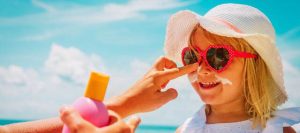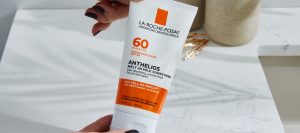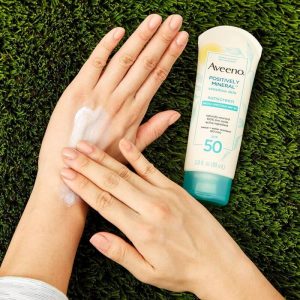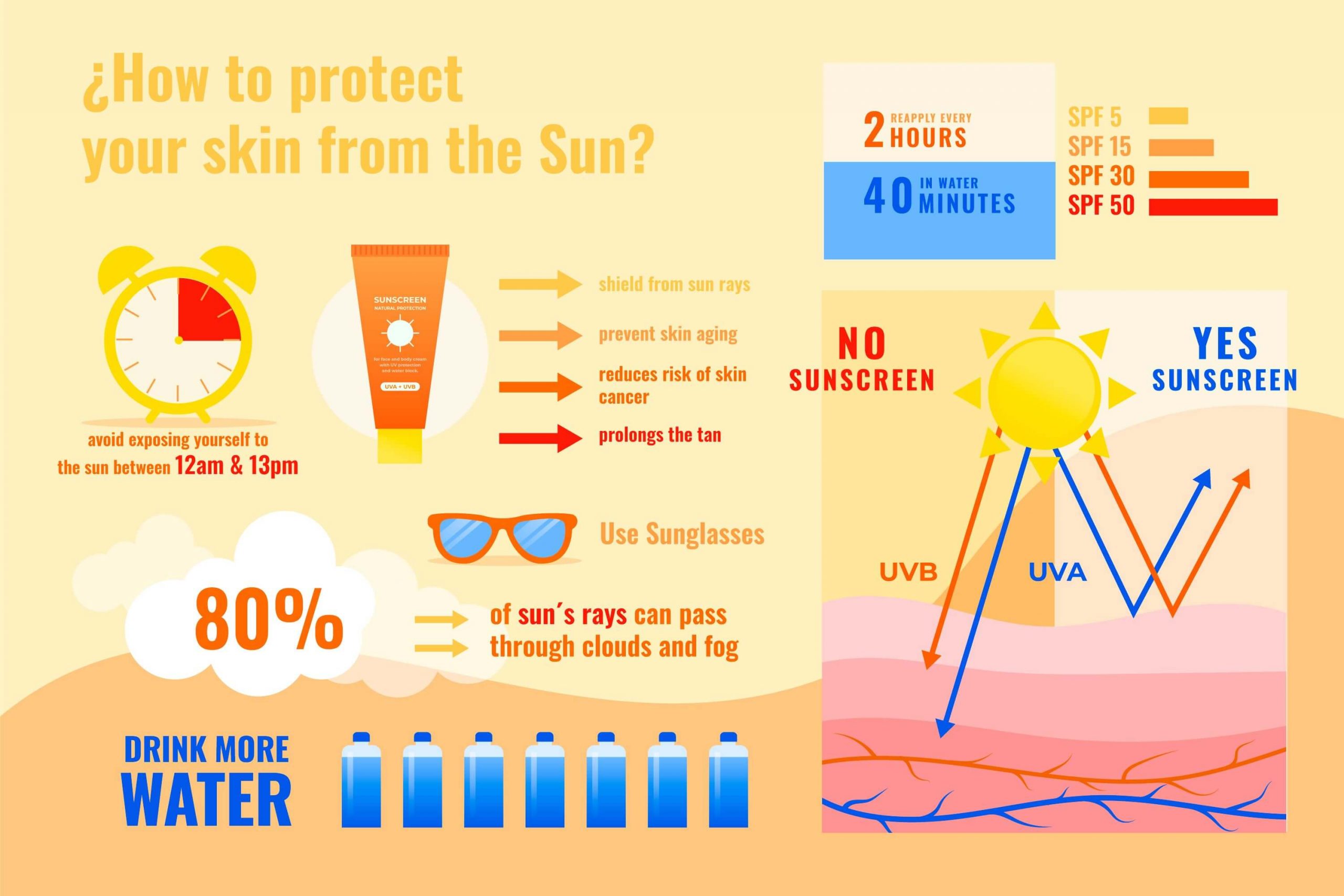The most important thing to remember about sunscreen is that all persons, regardless of skin color, 6 months of age and older, should use sunscreen on exposed areas of skin when outside (even on cloudy days). The second most important thing to remember is that any sunscreen is better than none. Ideally, however, you should use a product you trust to adequately protect your skin. We test sunscreens for their effectiveness against UVA and UVB rays. We also look at how well the Sun Protection Factor (SPF) listed on the product label matches the SPF of the tested sunscreen.
 SPF is a measure of a sunscreen’s ability to prevent sunburn caused primarily by ultraviolet (UVB) radiation. It generally represents the time it takes for a person’s exposed skin to burn with and without sunscreen. For example, if you would normally burn after 20 minutes of sun exposure without sunscreen, SPF 30 would theoretically protect you for 600 minutes, or 10 hours. However, once sunscreen is applied to the skin, it begins to break down and can also rub off. Therefore, it is necessary to reapply every two hours or immediately after swimming or sweating.
SPF is a measure of a sunscreen’s ability to prevent sunburn caused primarily by ultraviolet (UVB) radiation. It generally represents the time it takes for a person’s exposed skin to burn with and without sunscreen. For example, if you would normally burn after 20 minutes of sun exposure without sunscreen, SPF 30 would theoretically protect you for 600 minutes, or 10 hours. However, once sunscreen is applied to the skin, it begins to break down and can also rub off. Therefore, it is necessary to reapply every two hours or immediately after swimming or sweating.
Also Read: How to Clean Make-up Brushes
 What Are The Best Sunscreens For Face
What Are The Best Sunscreens For Face
Also, the intensity and wavelength distribution of UVB varies throughout the day and from place to place. Finally, no sunscreen blocks 100% of sunlight. Distribution: SPF 30 blocks 97% of UVB, SPF 50 blocks 98%, and SPF 100 blocks 99%.
SPF does not provide any information on sunscreen effectiveness against UVA rays either; UVA rays penetrate deeper into the skin than UVB rays. These rays cause sunburn and skin aging and, along with UVB, cause skin cancer. unlike UVB, which is at its strongest between 10:00 and 16:00, UVA is present for as many hours as there are hours of sunlight. Therefore, you need to look for a broad-spectrum sunscreen that protects against both UVA and UVB. Here’s what we say about testing sunscreens and how to find the best sunscreen for the face.
What Are The Best Sunscreens For Face | Comparison Table 2025
Top Quality | 5- Star Picks | Great Prices
| Image | Title | Buy | |
|---|---|---|---|
| EltaMD UV Clear SPF 46 Face Sunscreen, Broad Spectrum Sunscreen for Sensitive Skin and Acne-Prone Skin, Oil-Free Mineral-Based Sunscreen Lotion with Zinc Oxide, Dermatologist Recommended, 1.7 oz Pump | EltaMD | VIEW ON AMAZON | |
| La Roche-Posay Anthelios Melt-In Milk Body & Face Sunscreen SPF 60, Oil Free Sunscreen for Sensitive Skin, Sport Sunscreen Lotion, Sun Protection & Sun Skin Care, Oxybenzone Free | La Roche-Posay | VIEW ON AMAZON | |
| Thinkbaby SPF 50+ Baby Sunscreen – Safe, Natural Sunblock for Babies - Water Resistant Sun Cream – Broad Spectrum UVA/UVB Sun Protection – Vegan Mineral Sun Lotion, 6oz | THINK | VIEW ON AMAZON | |
| Neutrogena Ultra Sheer Dry-Touch Sunscreen Lotion, Broad Spectrum SPF 55 UVA/UVB Protection, Light, Water Resistant, Non-Comedogenic & Non-Greasy, Travel Size, 3 fl. Oz | Neutrogena | VIEW ON AMAZON | |
| Eau Thermale Avene Solaire UV Mineral Multi-Defense Sunscreen Fluid, Clean Formula Sunscreen for Sensitive Skin, Reef Friendly, Sheer, Non-Whitening, Antioxidant Protection, 1.7 fl.oz. | Eau Thermale Avène | VIEW ON AMAZON | |
| Aveeno Protect + Hydrate Moisturizing Face Sunscreen Lotion With Broad Spectrum Spf 60 & Prebiotic Oat, Weightless & Refreshing Feel, Paraben-free, Oil-free, Oxybenzone-free, 2.0 ounces | Aveeno | VIEW ON AMAZON | |
| Sun Bum Original SPF 50 Sunscreen Face Lotion | Vegan and Reef Friendly (Octinoxate & Oxybenzone Free) Broad Spectrum Fragrance-Free Moisturizing UVA/UVB Sunscreen with Vitamin E , Yellow , 3 oz | Sun Bum | VIEW ON AMAZON | |
| Paula's Choice Extra Care Non Greasy, Oil Free Face & Body Sunscreen SPF 50, UVA & UVB Protection, Water & Sweat Resistant, 5 Ounce | Paula's Choice | VIEW ON AMAZON | |
| La Roche-Posay Anthelios Tinted Sunscreen SPF 50, Ultra-Light Fluid Broad Spectrum SPF 50, Face Sunscreen with Titanium Dioxide Mineral Face Sunscreen, Universal Tint, Oil-Free | La Roche-Posay | VIEW ON AMAZON |
Prices and images pulled from the Amazon Product Advertising API on:
What Are The Best Sunscreens For Face | Product Overview 2025
1. EltaMD UV Clear SPF 46 Face Sunscreen
- EltaMD UV Clear SPF 46 face sunscreen for oily skin contains 9.0% Zinc Oxide, Niacinamide and an antioxidant to promote healthy skin while blocking harmful UVA and UVB rays from the sun
- Apply this face sunscreen for sensitive skin daily to help soothe sensitive skin types prone to acne, rosacea and hyperpigmentation
- EltaMD UV Clear oil free sunscreen protects against breakouts and is an essential acne sunscreen for those with acne prone skin care concerns
- Broad-spectrum SPF 46 coverage ensures this sensitive skin sunscreen helps protect you from the sun and is a daily face sunscreen for your everyday skin care needs
- This Zinc Oxide sunscreen is a non greasy sunscreen sensitive skin lotion recommended by Dermatologists that is fragrance-free, paraben-free, sensitivity-free, and noncomedogenic
2. La Roche-Posay Face Sunscreen
- Multi-award winning sunscreen with advanced protection in a fast-absorbing, velvety texture that leaves skin hydrated and smooth. Broad Spectrum SPF 60
- Water resistant (80 minutes)
- Formulated with Cell-Ox Shield technology: broad spectrum UVA/UVB protection with antioxidants. Formulated and rigorously tested for skin tolerance, even on sensitive skin
- Face and body sunscreen in a non-greasy, fast-absorbing texture leaves skin hydrated and smooth with a velvety texture
- Octinoxate- & Oxybenzone-free sunscreen provides broad spectrum SPF 60 protection
- Packaging may Vary.
- Fast absorbing, water resistant, non greasy texture that leaves skin hydrated and smooth with velvety finish
- High UVA protection (PFA 26) and SPF 60 for outdoor use that helps protect the skin from UV induced skin damage
- Photostable, longer lasting protection for all skin types
- Fragrance free, PABA free and Non comedogenic
- Tested on sensitive skin
3. Thinkbaby SPF 50 Sunscreen
- SAFE, NATURAL PROTECTION: Thinkbaby sunscreen provides effective SPF 50+ sun protection for babies. The broad spectrum UVA & UVB baby sunblock is suitable for daily use on infants’ sensitive skin, offering gentle defense against the sun’s rays
- EASY APPLICATION: The hydrating sun cream is quick and easy to apply to even the most active babies, and protection begins instantly. The fast absorbing kids sun lotion won’t leave skin feeling oily or sticky, and has no unpleasant chemical scent.
- CLEAN MINERAL FORMULA: The first sunscreen to pass Whole Foods Premium Care requirements, Thinkbaby vegan, Leaping Bunny certified sun creams contain no PABA, parabens, phthalates, BPA, oxybenzone, avobenzone, petroleum, gluten, dairy, or toxic chemicals.
- WATER RESISTANT: Your baby can splash, swim and play in the water safely. Our children’s sun cream provides the highest water resistance per the FDA, offering babies continuous protection for up to 80 minutes in the pool or sea before the sunscreen should be re-applied.
- REEF FRIENDLY: Safe for babies, and safe for the earth. Produced in the USA, our sunscreen’s active ingredient is non-nano Zinc Oxide, and the formula is highly biodegradable, non toxic and does not contain any known chemicals harmful to coral reefs.
Also Read: How to Remove the Redness of the Sun from the Face
4. Neutrogena Ultra Sheer Sunscreen
- 3-fluid ounce bottle of Neutrogena Ultra Sheer Dry-Touch Non-Greasy Sunscreen with SPF 55 that helps defend against the signs of sun and decrease the risk of skin cancer when used as directed
- This lightweight & sheer sunscreen is fast-absorbing with Dry-Touch technology for a non-greasy, matte finish and is formulated with Helioplex for superior sun protection for your skin
- Packaging and formulation may vary. New formula features an oxybenzone-free formula, this sunscreen lotion helps prevent sunburn and when used as directed, may help decrease the risk of skin cancer
- Both PABA-free and non-comedogenic, this lightweight sunscreen provides powerful face and body sun protection without the heavy finish, making it great to use for daily sun protection to keep skin protected during outdoor activities
5. Eau Thermale Avene Solaire Sunscreen
- Oxybenzone & octinoxate-free, this 100% mineral filter broad-spectrum SPF 50+ sunscreen offers UVA/UVB protection. Approved by the National Eczema Association & Skin Cancer Foundation.
- Its a lightweight, multi-defense shield against pollution & blue light. The sunscreen soothes & calms sensitive skin.
- This fragrance-free formula helps improve skin tone & visible redness.
- Apply to face & neck 15 min. before sun exposure. Reapply every 2 hr. & after swimming or sweating.
6. Aveeno Protect Hydrate Face Sunscreen
- 2-Fluid ounces of Aveeno Protect hydrate sunscreen Broad Spectrum face SPF 60 to help protect and provide all-day hydration to skin
- Made with nourishing prebiotic oat, this lightweight daily facial sunscreen helps leave skin feeling soft and moisturized all day as it combats sun induced radicals that accelerate skin-aging
- With a refreshing and weightless formula and a non-greasy feel, the invisible sunscreen face lotion also provides broad spectrum SPF 60 protection from harmful UVA and UVB rays. Plus its non-comedogenic, so it wont clog pores.
- This hypoallergenic sunscreen is paraben-free, phthalate-free, oil-free, Oxybenzone-free, dye-free and is water and sweat-resistant for up to 80 minutes, making it great to use during Outdoor activities
- From a Dermatologist- brand for over 65 years, Aveeno Protect hydrate face sunscreen helps prevent sunburn And decreases the risk of skin cancer and Early aging caused by the sun when used as directed with other sun protection measures
Also Read: Best Face Cream For 40 Year Old Woman
7. Sun Bum SPF 50 Sunscreen
- ORIGINAL SPF 50 FRAGRANCE-FREE SUNSCREEN FACE LOTION . This is the stuff we use every day. The sunscreen that started it all. We wanted a sunscreen to protect those who live and love in the sun, so we made it.
- MOISTURIZING SUN PROTECTION. Dermatologist and Sonny approved, this non-comedogenic sunscreen delivers UVA/UVB protection and is packed with Vitamin E. Our oil-free, water-resistant and reef friendly SPF 50 Face Lotion is great for all skin types.
- HOW TO USE. 15 minutes before sun exposure, apply liberally to all areas of the skin and avoid the eye area. For best results, reapply after 80 minutes of swimming or sweating. Sonny’s Tip: Apply every 2 hours for maximum sun protection.
- PROTECT YOUR SKIN. The key to practicing safe sun is to protect and moisturize your skin. Our Original Sunscreen line is Hypoallergenic and Oxybenzone, Octinoxate, Gluten, Cruelty and Paraben Free to ensure a fun day in the sun.
- TRUST THE BUM. What does that mean? It means trust us, the ones who live on the beach and need products that work on the most intense days in the sun. The simple truth is, when you make products to protect the ones you love, you make ‘em better.
8. Paula’s Choice Extra Care Face Sunscreen
- MATTE-FINISH BROAD SPECTRUM SUN PROTECTION: Wave goodbye to greasy sunscreen. Our lightweight, oil-free formula is SPF 50 & protects your skin from damage from UVB rays & UVA rays while enriching skin with antioxidants to promote a youthful appearance. PACKAGING MAY VARY.
- Paulas Choice Extra Care Non-Greasy Sunscreen is water- and sweat-resistant; ideal for outdoor & water-based activities. This silky oil-free formula is great for all skin types including oily and combination skin. Goes on smooth & dries to a soft matte finish.
- Never thick or greasy; our SPF 50 sunscreen is suitable for the face and body. This formulas soft matte finish can be worn with a bare face or under makeup. Protect your skin from further sun and environmental damage with antioxidants, vitamins A, E and C, hydrating aloe and oil-absorbing kaolin.
- Paulas Choice Skincare makes products that work. No fragrance, no parabens, no fluff. Just effective, science-backed formulas that target any concern from wrinkles to breakouts.
9. La Roche-Posay Anthelios Tinted Sunscreen
- This lightweight 100% mineral tinted face sunscreen with titanium dioxide was developed for sensitive skin and provides broad spectrum SPF 50 protection
- The fast-absorbing texture leaves a tinted matte finish on skin for a healthy glow.
- It is formulated with Cell-Ox Shield technology: broad spectrum UVA/UVB protection with antioxidants.
- Non-greasy, fast absorbing texture with a matte finish and universal tint for all skin types. Lightly tinted sunscreen with iron oxides to provide a healthy glow
- The Skin Cancer Foundation recommends this product as an effective aid in the prevention of sun-induced damage to the skin, including sunburn and possibly premature aging. When used regularly in the prescribed manner, this product may also help reduce the potential risk of skin cancer due to overexposure to sunlight.
- SPF 50 broad spectrum UVA and UVB protection
- Universal tint for instant healthy glow
- Ultra light texture
- Fragrance free, paraben free and water resistant (40 minutes)
- Recommended for sensitive skin
Also Read: Best Lightweight Moisturizer For Oily Skin
How To Choose The Best Sunscreens For Face | Unrivaled Guide 2025
The FDA is investigating the dangers of inhaling spray sunscreens. Do not spray directly onto the face. Instead, spray the sunscreen on your hands and then apply it to your face. Children are more likely to inhale the mist.
 SPF Value:
SPF Value:
SPF (Sun Protection Factor) is a measure of the amount of UV radiation needed to cause sunburn; the higher the SPF, the less likely it is to burn. It is important to note that SPF is related to the amount of solar energy, not the duration of sunlight, so reapplication depends on the intensity of the sun. Simply put, reapplication is more frequent during the day when the sun is at its maximum than at 9:00 a.m. when the sun is at its maximum. As mentioned above, a higher SPF does not mean you don’t need to reapply. Instead, consider what your skin needs. People who are fair-skinned need a higher SPF, while dark-skinned people (SPF 13.4 or so) can use a lower SPF (SPF 30 or so) and still be protected. Another thing to keep in mind is that SPF is for UVB only, but it is best to choose a broad-spectrum sunscreen, which protects the skin from both UVA and UVB.
Also Read: Best Anti aging Skin Care Routine For 40s
Chemical Or Mineral:
There are two types of sunscreens: chemical and mineral. Chemical sunscreens use organic substances such as oxybenzone, avobenzone, homosalate, octinoxate, octocrylene, and octisalate to provide sun protection. The product absorbs sunlight and converts it into heat, which is then released from the skin. This process takes about 15 minutes, so if you are using chemical sunscreen, allow at least that long before going outside.
Because of their properties, chemical filters tend to be cosmetically elegant and can be formulated into moisturizers and light oils. Chemical sunscreens have several disadvantages: first, they are not photostable and break down when exposed to UV light, so they require more frequent application than mineral sunscreens. Second, studies have shown that chemical sunscreen ingredients such as oxybenzone and octinoxate leach into the water while swimming and bleach the reef.
There are also chemicals associated with endocrine disruption, although the data are not conclusive. Chemical sunscreens tend to be more irritating because of the tendency to develop allergies to the active ingredients.
Mineral sunscreens act as a physical barrier to UV rays and disperse the light that hits the skin. The two main ingredients that act as a physical barrier are titanium and zinc oxide. They block a wide range of UV wavelengths and are photostable, so they do not need to be reapplied frequently (although the two-hour rule must be observed).
Titanium and zinc oxide are also resistant to all skin types, including sensitive skin, and are less likely to cause reactions. Zinc oxide is also important in the prevention of hyperpigmentation, which is why dermatologists often recommend it for patients with melasma and brown spots. Physical filters, unlike chemical sunscreens, are not gentle or light.
They also tend to leave a whitish residue on the skin, which is a problem for people with darker skin tones. Mineral formulas have made great strides with zinc nanoparticles that are more easily absorbed.
To get the best of both worlds, opt for a hybrid formula that includes both chemical and mineral filters.
Also Read: Best Makeup Advice For Over 50
Oxybenzone, Homosalate, And Octisalate Formulations:
The CDC has been focusing on oxybenzone for several years. This popular chemical has been found to be absorbed through the skin, and there is growing concern that it is an endocrine disruptor, as several studies have shown reduced testosterone levels in teenagers and increased risk of endometriosis in women. Currently, the European Commission (known to have stricter regulations on cosmetics and skin care than the U.S.) has set a limit of 6% for oxybenzone, but not all sunscreens list the concentration on their labels, so it is impossible to be certain. Homosalate and Etisalat have also been identified as possible endocrine disruptors, but these ingredients and their effects have not been well studied. However, these ingredients (and other chemical ingredients in sunscreens) have not been shown to be harmful at this time.
Concentration:
The concentration of sunscreen is important because its density affects how well it adheres to the skin. Those looking for a formula that is not heavy and greasy may choose a lighter formula, while those with dry skin may opt for a thicker, more nourishing sunscreen.
 Tips For Using sunscreen
Tips For Using sunscreen
Check The Expiration Date
Sunscreens are formulated to last at least three years according to FDA regulations. Bottles older than that is not guaranteed to protect you. If the bottle or box does not have an expiration date and you do not remember the date of purchase, it is best to play it safe and buy a new sunscreen.
Shake It Up
It may not be in the instructions, but it’s a good idea to do it because it helps distribute the active ingredients of the sunscreen throughout the product.
Use Enough
CR tests have shown that halving the proper amount of sunscreen reduces the protective effect of SPF by about half. Apply sunscreen 15-30 minutes before going outside. For lotions, one shot glass (about 30 grams) is a good rule of thumb for covering the entire body with a bathing suit. One teaspoon for the face, head, and neck; one for the arms; one for the legs; one for the chest and belly; and one for the back and neck. For sprays, apply just enough to blend into the skin and repeat.
Also Read: Best Products For Cystic Acne
Don’t Forget The Places That Are Often Forgotten
These include the lips, back of the hands, back of the feet, back of the neck, scalp, and ears.
Reapply
Regardless of the type of sunscreen, reapply every two hours and immediately after swimming or sweating.
Spray-Type Sunscreens Should Be Used With Caution
The correct way to use a spray is to hold the nozzle 10 to 15 cm away from the skin and spray until the skin glistens, then blend. Even if the spray says “do not rub,” pressing it into the skin will increase its protective effect. Then repeat the process, just to be sure.
The FDA is investigating the dangers of inhaling spray sunscreens. Do not spray directly onto the face. Instead, spray the sunscreen on your hands and then apply it to your face. Children can easily inhale the mist, which can cause irritation to the lungs. Consumer Reports recommends using lotions rather than sprays for children, but if you do use a spray, be very careful when applying it. It is best to spray it on your hands and rub it into your child’s skin. At the very least, ask the child to close their eyes and mouth and turn their head while spraying. Finally, the spray is flammable, so if you are going to put it near an open flame, make sure it is dry.
Also Read: Best Body Scrub For Sensitive Skin
What Are The Best Sunscreens For Face | Infographics

What Are The Best Sunscreens For Face | Video Explanation
FAQs
What are three key points to consider when buying sunscreen?
Here are three key points to consider when buying…
- The SPF (Sun Protection Factor) should be 15 or higher. The SPF value of a sunscreen indicates how long it can prevent sunburn before it needs to be reapplied
- Covers a wide range of frequencies
- Waterproof protector
Is SPF 70 better than SPF 50?
According to experts, sunscreens with SPF 50 or higher are not worth buying. The protection is only marginally better. It may also encourage you to spend more time in the sun. Instead, choose one with SPF 15-50, apply generously, and reapply often.
What sunscreens are safe?
For now, dermatologists say that so-called “mineral” or “physical” sunscreens containing zinc oxide or titanium dioxide are safest if you are concerned about health effects. These are the only sunscreen ingredients that the FDA says are “generally recognized as safe and effective.”
Also Read: Best Deodorant For Sweating
Conclusion
Check reviews and look for sunscreens that have performed well in tests. If you can’t find one, choose a sunscreen with chemical active ingredients and an SPF of 40 or higher, based on years of testing, which will give you a better chance of getting at least an SPF of 30. It is better to use sunscreen than not to use sunscreen, but it is only one of the smartest sunscreen solutions.
 Cosmetics Capture is an online shop where you can find the best and certified Makeup, Beauty and Personal Care products For all genders.
Cosmetics Capture is an online shop where you can find the best and certified Makeup, Beauty and Personal Care products For all genders.